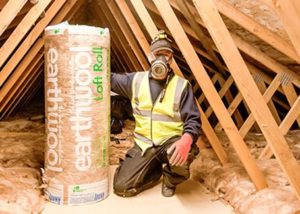It is common knowledge that most of the heat in your home is lost through the roof. In fact, about, 25% of the heat will be lost through the roof.
Insulating your roof well will not just help to keep you warm in the winter and cooler in the summer, it will also save you a lot of cash in the process. It is an effective way to reduce household bills annually by a few hundred pounds. The Energy Saving Trust has worked out that insulating your loft can save you from £165 to £195 depending on the size of the house. Furthermore, you will find that it can significantly reduce your carbon footprint. This is because the less heating you use on a daily basis, the better it will be for the environment.
The insulation, if done correctly, should last for around 40 years and can actually add value to your home when it comes to selling it.
If you are wanting to build a loft conversion, there is no question that you will need to insulate your loft as part of that.

If you like the sound of that and are thinking of doing a loft insulation, then we have some things for you to consider in this guide.
How does it work?
Think about a loft insulation like a rug for your loft. What happens is a mineral fibre material is laid between the joists and then over the joists in your attic space. This thick material traps heat which will normally escape through the roof. It will also stop draughts getting in too.

The Benefits of Loft Insulation
Insulating your loft can help you reduce the amount of heat that is lost and save money on your heating bills.
Loft insulation is very quick to install and require minimal upheaval in order to carry out the process.
Once it is installed, there is no further maintenance required.
If you already have loft insulation, you will be able to reap the benefits from a top up depending on how long it has been there for. If the insulation is 100mm or less, you can look to get it increased to the recommended level of 270mm.
Types of loft insulation
If you have a loft which is easy to access and has no signs of damp or condensation problems, it should be rather easy to insulate. However, you will probably still want to get a professional installer to do the job properly. Nevertheless, it can be a DIY job if you so wish.
If your loft is used as a room after a loft conversion, then you can insulate your roof rather than the loft floor. This will typically be done by fixing rigid insulation boards between the roof rafters.
If you have a loft which is rather difficult to access, you can have blown insulation which will need to be installed by a professional. Here, they will use specialist equipment to blow loose, fire-retardant insulating materials into the loft space. This is a quick process, usually only a few hours.
If you have a flat roof, it will need to be insulated from above. The best time to carry out this task is when the roof covering needs replacing anyway. If your flat roof needs to replaced anyway, you should now make sure that you insulate it properly to comply with building regulations.


